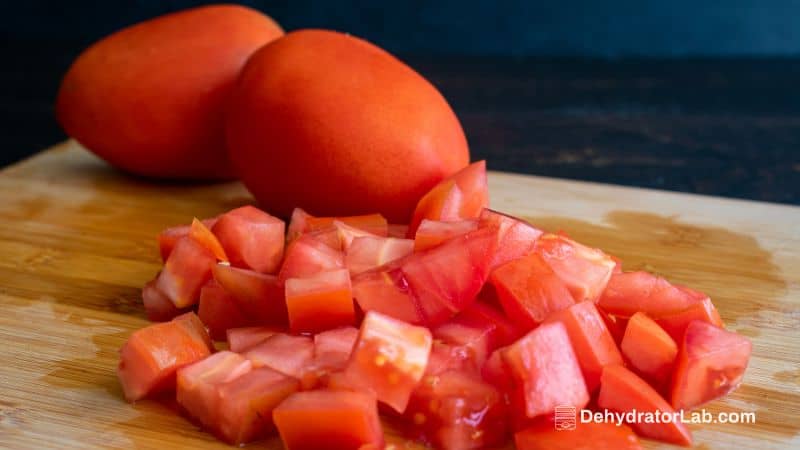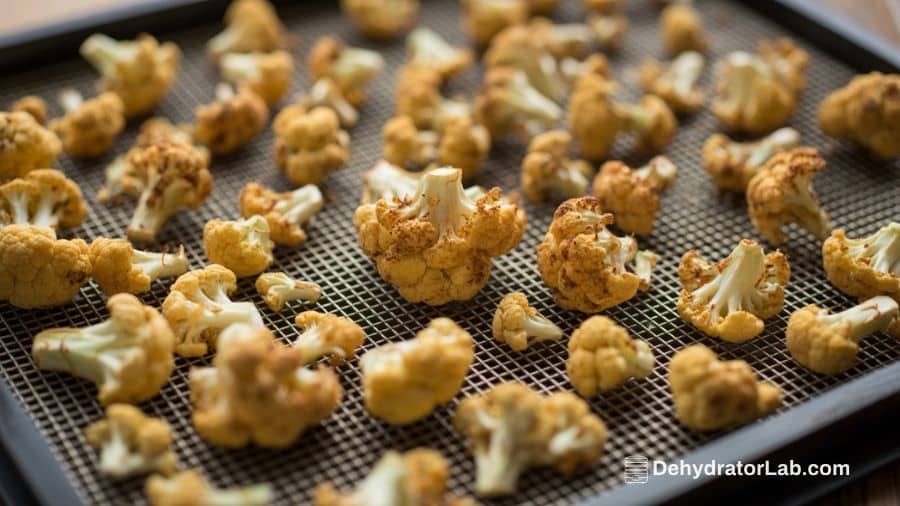In this article, I’ll be showing you how to dehydrate food without a dehdyrator, but with commonly found items around your home.
The act of drying food for preservation is as old as mankind. Evidence shows that our early ancestors actively dried food as early as 12,000 B.C. Here is a timeline about the history of food preservation. This was thousands of years before the invention of electricity, leave alone the modern-day dehydrators.
What this clearly means is that you don’t need to invest in a dehydrator to dry your favorite foods for long-term use. For those who live off the grid, I also have a few techniques of how to dry food without electricity.

In this article:
How to Dehydrate Food Without a Dehydrator
1. Dehydrate Food With The Regular Oven
An oven is a common appliance in most homes. While it’s not necessarily designed to dehydrate food, it can be perfectly used for that. You only need to know how to play with the temperature and time settings.
Mind you, if you have yet to eat dehydrated foods, your oven will offer a great way to experiment and let you decide whether to invest in a dehydrator or not.
To dry your fruits or jerky in the oven, you’ll need:
- Cookie sheets (any flat pan will do though)
- Wax paper
- Mandolin knife
- Spatula
- Lemon juice (used when preparing fruits)
Cut your fruits, veggies, and meat into ¼-inch cuts (0.63cm) and place them on a cookie sheet which has been lined with a wax paper.
The next step is to prepare your oven for the task. All you need is to set it at the lowest temperature (preferably 180℉). If your oven doesn’t offer these temperature options, simply set it at under 200℉. This should do for most foods.
Tips For Drying Food In The Oven
- Rotate the food throughout the drying process to ensure even dehydration. For excellent results, I would recommend you to turn the food slices at even intervals (let’s say after every 1 hour) to for even dehydration on both sides.
- If you’ll be using several pans, be sure to position them a few inches apart for even air circulation
- A regular oven will take 6-10 hours to dehydrate food properly. As a rule of thumb, juicier foods take longer than drier food.
- That being said, using an electric oven might seem a little bit expensive.
2. Dehydrate Food Using A Toaster Oven
If you are not planning to dehydrate lots of food at once, then your toaster oven should do just fine. The key benefit of dehydrating food using a toaster oven is that you won’t be interrupting the use of the main oven.
I also find it more reliable since most of them have much lower temperature settings than regular ovens.
To Use Your Toaster Oven
- Simply turn it to the lowest temperature setting possible (120℉-150℉ is a good range to kill most germs and give you a perfect snack).
- When drying food using a toaster oven, you’ll still need to cut the food into thin slices and place them onto a parchment paper to prevent them from sticking onto the metal tray.
- After 3-4 hours, the tops should be fairly dry. Flip it to the side to prevent burning.
Tips For Using A Toaster Oven To Dry Food
- Unlike a regular oven, most toaster ovens don’t have a fan to circulate the hot air evenly across the food. Thus, you’ll want to keep on turning the food for even drying.
- Secondly, the temperature inside the toaster tends to spike with time. Therefore, you’ll want to keep an eye on it to prevent the food from burning.
- Using an oven thermometer might help you keep the temperatures within the required ballpark. If you don’t have one, consider leaving the oven door slightly open to prevent heat build-up.
3. Dehydrate Food Using A Microwave
I bet you didn’t know that you can dehydrate food using a microwave. We all know that this appliance works by sealing in the moisture content which is quite the opposite of dehydrating. But with a few tricks, you can dry your apples and herbs in no time. Tho there is a difference between a dehydrator and a microwave oven
I don’t recommend drying jerky in the microwave considering how long it takes to prepare. Instead use a dehydrator machine for jerky.
This method requires foods that dehydrate quickly such as apples and herbs.
How To Dehydrate Herbs In The Microwave
- Clean the herbs and use paper towels to dry them.
- Spread a paper towel on the rotating plate of the microwave and generally arrange a cup of the herbs on it.
- Use the High Power setting to dry the herbs for 2-4 minutes.
- Important: Rearrange the herbs after every 30 seconds to prevent burning them.
- After 2-4 minutes, remove the herbs for inspection. If okay, let them cool down before transferring on the storage can. You might want to repeat the process for a minute or 2 if they are not dry enough.
How To Dehydrate Apples In The Microwave
- Cut the apples into ¼-inch thin slices. You might want to use a mandolin if you want consistency. But don’t make them too thin as they might stick on the rotating plate.
- Clean the rotating plate of the microwave and dry it since you’ll need to place the apple slices directly onto it
- Spread the slices on the plate.
- Use the defrost setting to dry them for 30-35 minutes. Remember to turn them after every 10 minutes or so. Note that using the regular microwave setting will burn your fruit slices in a matter of minutes.
Available to read: best apples to dehydrate
Alternate Methods To Dehydrate Food Without Electricity
As I told you earlier, the people of old didn’t rely on electricity to dehydrate their food nor on some other kitchen small appliances. And it’s still very possible to do the same today.
Here is how to dry your food when the grid goes down!
4. Dehydrate Food Using Fire Drying
This is one of the oldest methods. It works best for meat, although vegetables and fruits can also be dried by placing them on the ground near the fire.
To dehydrate jerky using fire:
- Prepare the meat by cutting it into thin slices.
- Use hardwood to create a fire. A charcoal grill or a fire pit also works great.
- Come up with a way of hanging your food on top of the fire. Using poles to make a bed is the best idea. You’ll then hang your strips of meat on the poles running across the fire. You could also use strings to hang the food atop the fire.
- Remember that the food shouldn’t be so close to the fire or else you’ll be cooking it. Hang the food at a height where you can keep your hand for some time without getting burnt.
- Keep the fire smoldering all day or until the meat strips are just perfect. You might want to bring the jerky isn’t perfect at the end of the day.
- You’ll know that your meat is ready if some fibers are exposed upon bending the dry strip.
5. Simply Hang Them In Open And Dry Airspace
Do you live in a dry area that gets quite hot? Well, you don’t really need a dehydrator. Simply look for a good spot free of bugs and pests. Ideally, this spot should have a good airflow and should reach temperatures of 90-100F during the day.
To keep the bugs out, simply use a net to create a bag. This method works best for flowers, small fruits such as cranberries, and leafy items.
6. Dehydrate Food Using Your Car
Besides taking you where you need to be, you could use your vehicle as a diy dehydrator. Vehicles tend to build up a lot of heat when parked in the sun. They also get quite warm even in winter thereby making them ideal for dehydrating food throughout the year.
To dry food inside the car:
- Prepare the food that you wish to dry. Similar to other dehydrating methods, cut the food into thin slices to fasten the process and prevent the growth of molds.
- Place the food in trays with spaces between them.
- Fruits that brown easily when exposed to air such as apples and bananas might need to be dipped in lemon juice first.
- Cover the foods with a light cloth to keep pests out and place the trays on the seats.
- Leave a small crack in the windows for adequate air circulation.
If you don’t have trays, you could simply hang the food with strings making sure that it does not take touch anything. To do this, you could run several strings through the windows by hanging a small weight on either side. Hang your food on the ‘line’ inside the car and let it dry slowly
It might take a day or two for the food to dry completely depending on how hot the inside of your car gets
For those who live in extremely sunny areas, you could simply place your food in trays and put them on the top of the car. A light cloth or a net could be used to keep the pests out.
7. Dehydrate Food Using A Black Tarp Or Clean Trash Bag
Black tarp and trash bins accumulate a lot of heat when spread on the ground in the sun. This helps in creating a perfect drying zone for a variety of foods.
Your food will need some form of protection from flies and other bugs. Spreading a net or light cloth on top might help.
8. Use A Home-Made Dehydrator
A food dehydrator works by creating heat using a heating element. The heat is then circulated across the food to remove moisture by a fan.
Based on this principle, you could easily make a home-made food dehydrator with easily available materials around your home and if you need further inspiration, here are 10 uses for the food dehydrator I’ve already written a guide on how to make a solar or electric homemade food dehydrator in this article.
Store Your Dried Food For Future Use
Your food will take a varying amount of time to dry depending on the type of food and the type of method that you are using. An easy way to tell whether the food is okay is the cracker effect.
Perfectly dried food should snap in half. If it bends, then the chances are that it needs more time to dry.
After drying, you’ll need to put away the food for future use. Vacuumed containers perform the best in keeping your dried food safe for prolonged periods (Check our best food vacuum sealer reviews here).
You could also use airtight containers. Metallic and glass models are the most preferable since plastic tends to let in air with time. Learn how to store your dehydrated food in this article.



